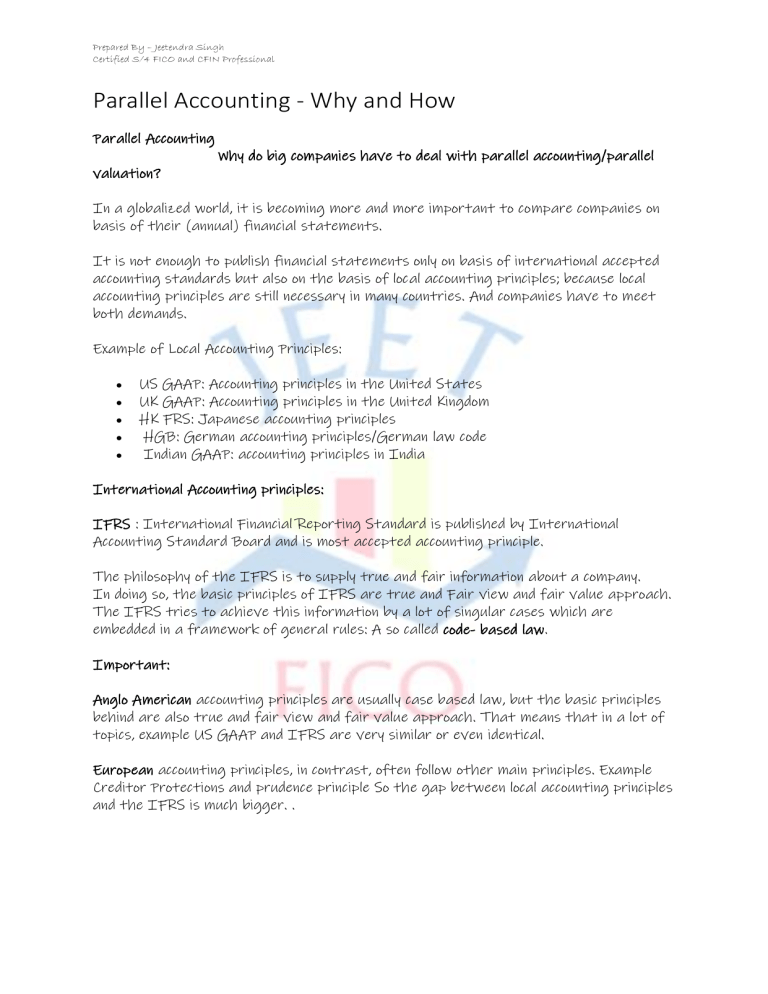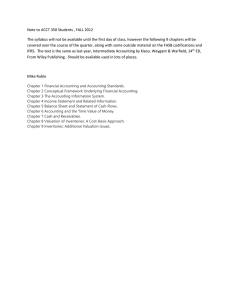
Prepared By – Jeetendra Singh Certified S/4 FICO and CFIN Professional Parallel Accounting - Why and How Parallel Accounting Why do big companies have to deal with parallel accounting/parallel valuation? In a globalized world, it is becoming more and more important to compare companies on basis of their (annual) financial statements. It is not enough to publish financial statements only on basis of international accepted accounting standards but also on the basis of local accounting principles; because local accounting principles are still necessary in many countries. And companies have to meet both demands. Example of Local Accounting Principles: • • • • • US GAAP: Accounting principles in the United States UK GAAP: Accounting principles in the United Kingdom HK FRS: Japanese accounting principles HGB: German accounting principles/German law code Indian GAAP: accounting principles in India International Accounting principles: IFRS : International Financial Reporting Standard is published by International Accounting Standard Board and is most accepted accounting principle. The philosophy of the IFRS is to supply true and fair information about a company. In doing so, the basic principles of IFRS are true and Fair view and fair value approach. The IFRS tries to achieve this information by a lot of singular cases which are embedded in a framework of general rules: A so called code- based law. Important: Anglo American accounting principles are usually case based law, but the basic principles behind are also true and fair view and fair value approach. That means that in a lot of topics, example US GAAP and IFRS are very similar or even identical. European accounting principles, in contrast, often follow other main principles. Example Creditor Protections and prudence principle So the gap between local accounting principles and the IFRS is much bigger. . Prepared By – Jeetendra Singh Certified S/4 FICO and CFIN Professional How can SAP ERP fulfil the requirement of parallel accounting/valuations? The answer to that question depends on the used general ledger. If new G/L accounting is used than 2 options. • • The accounting solution. The Ledger solution If Classic G/L accounting than there is only 1 possibility • The accounting Solution Note. SAP generally considered. The Ledger solution and the account solution as equal. Complete or delta - What is the difference? Assume any (Period end) accounting issue that has to be balanced with parallel values. • • According to IFRS. With €5000 and According to local accounting standard with €7000 In any case. We will have to post 2 documents. Complete posting. Means to post one document(The international one) with an amount of €5000. And the other, the local one with €7000. Delta posting Means we first have to decide which valuation is basis. “Historically grown”, Let's assume it should be the local one. So, the first document is posted with the amount of €7000 In a second document we only will post the difference. And amount of € -2000 has to be entered. Note: SAP clearly recommends complete documents. If you decide to use Delta documents, you will get a mixture of delta and complete documents. Because SAP programs such as the foreign currency valuation run and the depreciation run are not able to post Delta values. Moreover, Delta postings are only possible with manual transactions. Prepared By – Jeetendra Singh Certified S/4 FICO and CFIN Professional Accounts Solution Working of accounts solution In general: Business example. When SAP company is using a parallel valuation and decided to run account solution; To correctly reproduce the business cases in the system, The company Must understand that valuation differences will be stored on different FI accounts. Accounts Solution for Parallel Valuation: A company that decides to use the account solution for parallel valuation have to use additional GL accounts to report the differences. Means only accounts which represent valuation differences have to be newly created. A lot of accounts, called shared accounts will stay the same and will still be used as before. Shared accounts example. • Receivables. Payables. • • Cash and bank accounts. • More or less all expense and revenue accounts. Shared Account Posting Example Vendor invoice of spare Parts will look the same no matter if you have implemented parallel accounting or not. The same accounts are posted. Reason. There are no valuation differences between the different accounting principles. Prepared By – Jeetendra Singh Certified S/4 FICO and CFIN Professional Parallel accounting: Typical Period end processes with valuation differences • • • • (Manual) posting of provisions. Valuation of postings in foreign currency. Valuation of adjustment of doubtful receivables. Valuation of fixed assets. Posting of depreciation in asset accounting. Assumption: Locally we are allowed to depreciate an asset. With APC = €20,000. Over 5 years, useful life. The accounting records. At the end of one year looks like. Ordinary depreciation (Expense) account with €4000. To Accumulated depreciation (ADP) Account with €4000. If an international accounting principle allows depreciations over 4 years, then accounting record at the end of the one year's look like Ordinary depreciation expense account with €5000 to accumulated depreciation ADP account with €5000 Note: To avoid wrong values/balances these amounts can not be posted to the same accounts. Prepared By – Jeetendra Singh Certified S/4 FICO and CFIN Professional Illustration of the Asset Acquisition with Vendor and depriciation Prepared By – Jeetendra Singh Certified S/4 FICO and CFIN Professional Ledger Solutions If a company has to map a parallel valuation and decides to run the ledger solutions. Valuation differences will be post in the different FI ledgers. Basic: In every client, exactly one leading ledger is used to post by all company codes. • The leading ledger therefore should be used to reflect international accounting principles. • Only leading ledger is integrated with CO in the standard system. Additional Non-leading ledger can be defined with in the general ledger. • The local reporting principles like USGAAP, HGB, UKGAAP, Indian GAAP can be mapped using non leading ledgers by different company codes. • Tax ledger can also be mapped as a non-leading ledger. All ledgers work with the same accounts, valuation differences are stored at different ledgers not at the different accounts. Prepared By – Jeetendra Singh Certified S/4 FICO and CFIN Professional To better understand Parallel Valuation difference in the account and Ledger Approach lets see foreign currency Valuation. What is FCV - Foreign Currency Valuation? Open Item managed G/L accounts, customer and Vendor Open Items posted in a foreign currency need to be valuated. Assume that International Accounting Principles follows Always Evaluate procedure which means item to be valuated in the BS is with the exchange rate of the current valuation date – no matter if that means valuation profit or valuation losses. And the local accounting principle follows Lowest Value Principle means Asset entry is only valuated if new valuation is less than the previous value and Liability entry is only valuated if valuated amount is higher than the previous valuation. In this business case, vendor invoice of 1000 USD is posted with EUR/USD exchange rate = 0.80 and FCV runs is done with the EUR/USD exchange rate = 1.00. Accounts Solution Different accounts as per accounting Principles Ledger Solution: Same accounts with different Ledgers Prepared By – Jeetendra Singh Certified S/4 FICO and CFIN Professional Hope this documents helps you to understand Overview of Parallel Accounting, how is this implemented in the SAP and its few use cases for developing the understanding. Happy Learning and Keep Growing






